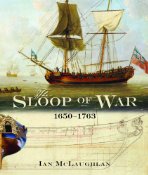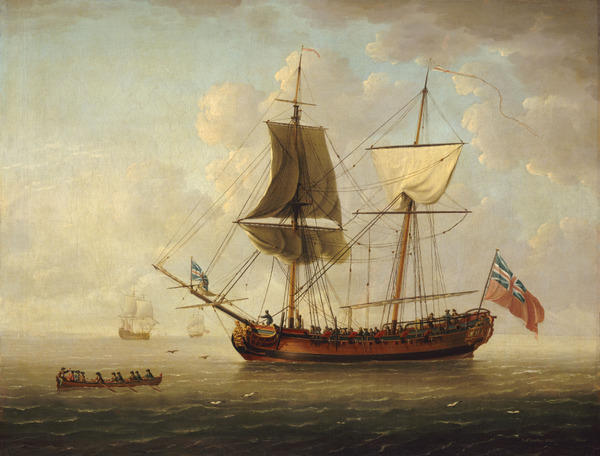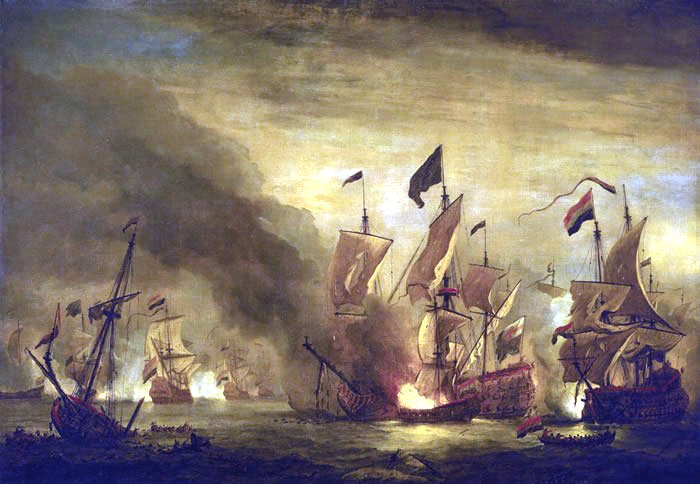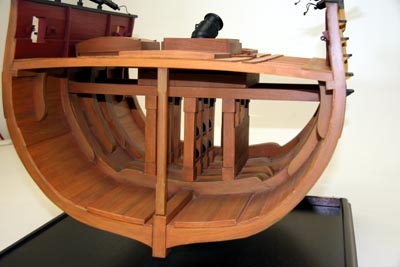
Sloop of War 1650 – 1763
 Sloop of War  1650 – 1763 came to WWTFT courtesy of the Naval Institute Press. Seaforth Publishing, an imprint of Pen and Sword Books has produced a beautiful new book. The amount of research done by author Ian McLaughlan and Derek Andrews, to whom the book is dedicated, is simply astounding.
Sloop of War  1650 – 1763 came to WWTFT courtesy of the Naval Institute Press. Seaforth Publishing, an imprint of Pen and Sword Books has produced a beautiful new book. The amount of research done by author Ian McLaughlan and Derek Andrews, to whom the book is dedicated, is simply astounding.
Inspired by a feeling that the literature was lacking on this unappreciated class of sailing ship, McLaughlan made it his mission to give the sloop its due. Â Â In the introduction he appears positively indignant about this state of affairs.
Many books have been written out of a mild sense of anger or frustration and this is certainly true of this one. Over the years, particularly during the last three decades, there have been countless volumes written – many in the greatest detail – on the ship of the line and other rated ships down to Sixth Rate frigates. Very little has been said about the sloop of war or her counterpart, the French Corvette. This is astonishing since this class of warship became, by the end of the Napoleonic wars, the most numerous of all in the Royal Navy.
McLaughlan is as passionate as he is meticulous about his topic. One might think that he is unique in his obsession. Apparently this is not the case.  Of Derek Andrews, McLaughlan says,
Derek Andrews was a teacher of English at a grammar school just outside Birmingham. He has never lived near the sea and has no experience of sailing or seafaring in his background. Yet from some inexplicable reason he developed an almost obsessive interest in these tiny warships. It may be that he was struck by their form and beauty. Whatever the reason, it took him into years of work, at the then public Record Office researching old, crumbling Admiralty documents, unearthing a a mass of detail which he would then analyze to draw comparisons and develop arguments as to the shape, form and rig of these vessels.
Whatever their motivations, McLaughlan can take comfort in having set the record straight and in having given the Sloop of War the attention he felt it was owed.
Although dedicated to one particular class of sailing ship (and the author might well take exception to this note given his particular feelings about the sloop) some of what he has to say in his chapter on rigging pertains to other sailing ships of the period and even those after.* To someone totally unfamiliar with some of this terminology, some of the nomenclature would be good candidates for the Balderdash board game. For example, most people probably wouldn’t have a clue what a clew is, or the vaguest idea of what a vang is, much less a boom vang. There are all manner of strange terms with very particular meanings (in one of the Patrick O’Brian novels, Dr. Maturin has a humorous discourse on some of these terms.) Some sails have pendants, bonnets, earrings, reefs, and a host of other attributes.  Regardless of how obscure, McLaughlan makes their meanings clear via numerous diagrams and sketches.
He explains that in order to fully understand the evolution of the sloop, which is what this book covers, one has to get a sense of the variety of configurations that the sloop might have taken. It wasn’t just a matter of how many masts (generally two, sometimes three – ship-rigged, and rarely one), but what kind of sails it bore and how those sails were configured. This class of ship was known under many variations based on the rigging- for example the brigantine, barque, snow, and ketch configurations. The number of options were literally unlimited, because unlike its larger brethren, the sloop of war was the product of an experiment, due to necessity as well as a looser set of standards governing their construction and the purposes to which they were dedicated.
These smaller ships were used for a variety of purposes. Sometimes they were built for speed and agility, sometimes they were constructed to be stout and tough, for the purpose of being platforms for mortars – bomb throwers. The fact that these guns weren’t designed to roll on carriages to absorb recoil necessitated a stiff construction that hampered the ships’ sailing abilities. In contrast, a packet ship (designed for carrying messages and diplomats) relied on speed, rather than armament.
With the exception of sloops which served as Royal Yachts, these ships were commanded by a lower ranking officer, known as a Master and Commander, like the title of Patrick O’Brian’s first book in his famous Aubrey-Maturin series. Because a sloop could sometimes be “ship-rigged†with three masts, the number of guns carried by a ship, was finally (1720) the defining characteristic of what differentiated a sloop from a rated warship (20 guns or more). Rated ships (1st – 6th) merited a Post Captain (the title of O’Brian’s second Aubrey-Maturin book).
Regardless of the eminence of their command, these small ships fulfilled a number of functions, and their captains (an honorary title denoting command of a ship, rather than actual rank) bore significant responsibility. Often they attended fleets, serving as a means of communication between ships. Similarly, when captains of the larger, deeper draft, rated ships were chary of running their ships aground, these nimble, shallow draft vessels were used to take soundings. Sometimes their duties were more dangerous, such as when they were used to tow fire ships away from the fleet- or toward an opposing one. Fire ships were generally old or worn out rated vessels with at least two decks. These ships were deliberately set on fire and sent to drift or sail into the midst of an enemy fleet so as to cause destruction and wreak havoc. They made for a terrifying weapon …
Warships of the age of sail were highly vulnerable to fire. Made of wood, with seams caulked with tar, ropes greased with fat, and stores of gunpowder, there was little that would not burn. Accidental fires destroyed many ships, so fire ships presented a terrifying threat. With the wind in exactly the right direction a fire ship could be cast loose and allowed to drift onto its target, but in most battles fire ships were equipped with skeleton crews to steer the ship to the target (the crew were expected to abandon ship at the last moment and escape in the ship’s boat). Fire ships were most devastating against fleets which were at anchor or otherwise restricted in movement. Wikipedia
When sloops were built in many instances (1672-1673) to counter fire ships, they were generally of a different sort of construction than the fire ships themselves. The author contends that the “purpose-built†fire ships weren’t generally qualified as sloops, because they generally featured notable differences in their construction, such as a specially designed lower deck for carrying combustibles with ports to facilitate drafts for a bigger conflagration. In addition, they were also often “ship-riggedâ€, or equipped with three masts.  Consequently, he suggests that their closest connection may have been as opponents, as indicated above.
If fire ships couldn’t properly be classified as sloops, there may be a stronger argument for so classifying the bomb ketch. Both were specialized vessels, and as such were often co-opted for other uses when there was need. The bomb ketch bore more similarity in design with respect to its rigging and layout. However, because of the weight of the weaponry and the amount of space it took up, these ships didn’t have great sailing qualities and often required an accompanying support ship to carry men and the munitions to operate it. It seems as though the author is content to categorize them as sloops – albeit with a few differences.
Although the book covers the period between 1650 and 1763, according to the author, the first ships explicitly built to be war sloops appeared as a consequence of the War of Spanish Succession between 1704 and 1719. During this war there was a pressing need to protect commercial shipping’s use of inshore and shallow waters from the depredations of privateers. The smaller 6th rates weren’t meeting the need. To address the problem, the Royal Navy began a program of building a number of both single-masted and ship-rigged sloops. Each class was characterized by a particular ship (and time period) which served as the group’s archetype. The ship-rigged set is referred to as the Otter Group, while the single masted sloops were in two groups, Jamaica and Happy.
Between 1728 and 1749 the sloop not only began to mature in design with the Admiralty requesting and getting some proposals for standards in their design, but they also began to see increasing use in a variety of roles. They began to play an expanding role in protecting British coasts and interests in the Mediterranean, West and East Indies. At war first with Spain in 1739 and then France in 1744, the British Navy was stretched pretty thin. This may have contributed to increase use of the sloop, which could quickly be built using commercial ship-yards. In addition, the threat from privateers was still present, but fortunately the ships that were being used as privateers were more commensurate with the size of sloops than larger rated ships. The design of the bomb-ketch by this time had begun to share more characteristics with the sloop, which improved its sailing qualities and makes its designation as a “half-sister†to the sloop even more reasonable. From the start, these vessels had been used for multiple purposes based on need. They added to the versatility of the ships known as sloops.
Although the time period covered in this book ends in 1763, that does not mean that Sloops were no longer being produced. On the contrary, there was an explosion in their use that, in the words of the author, would have made the book “impossibly large.â€Â The period covered shows the “most radical and varied development†of the technology.
Whether you are serious scholar, a devotee of naval history, or just someone who likes a good book, Sloop of War does not disappoint. Most of us can’t devote a lifetime of study to this topic, much less gain access to the mouldering records so assiduously researched by the author. Thanks to McLaughlin, we don’t have to in order to find out about the interesting history of this class of ship.  Sloop of War is at once an extremely detailed academic treatment of early Royal Navy warships, and simultaneously a reference work that could grace any coffee table.
*As a fan of Patrick O’Brian and C.S. Forester, the beautiful diagrams and clear explanations were welcome and interesting. This is perhaps due to the vast amount of experimentation to which these unrated ships were subject. Unlike their larger counterparts, there were no fixed standards set for them. This is perhaps what governed the author’s choice of time-period, which he refers to as the “origins and birth†of this class of ship. The ships of O’Brian and Forester were those of a subsequent period when much of the science of building sailing ships had been hashed out through hard-won experience.



 The posts are coming!
The posts are coming!

2 comments
Thanks so much for taking the time to write this review! I’d been on the fence about this book, not having the option of flipping through it, and the review helped me make up my mind (I’ll be buying it). Very much appreciated!
[Reply]
Martin Reply:
August 14th, 2014 at 11:02 am
You are very welcome Chris. The book is very nice and extremely thorough and detailed. I am pleased that you found my review useful.
[Reply]
Leave a Comment